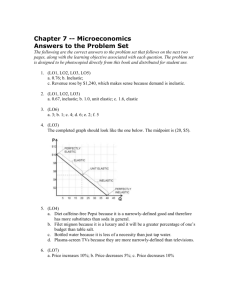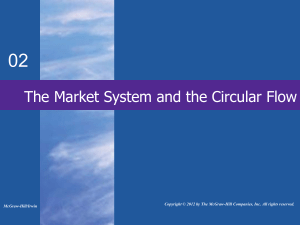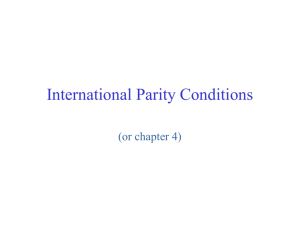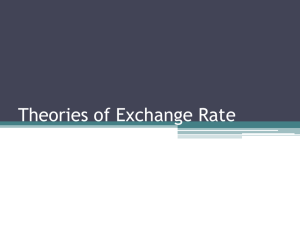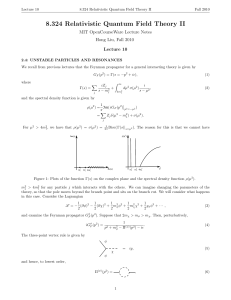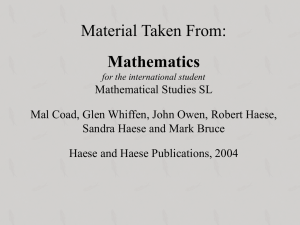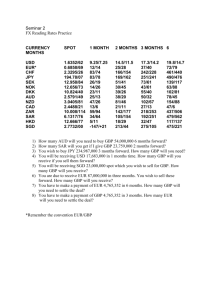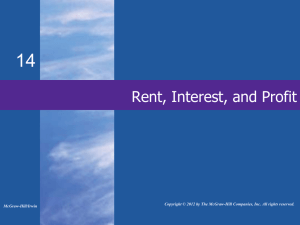LO3 21-1
advertisement
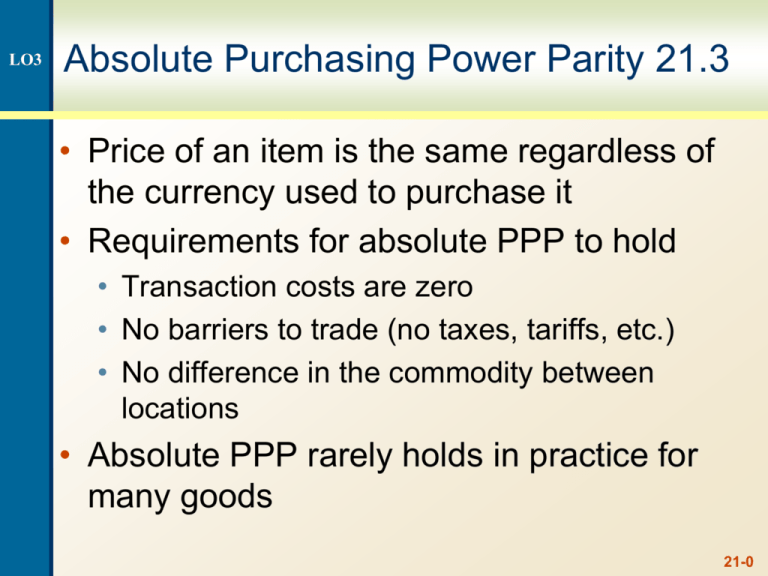
LO3 Absolute Purchasing Power Parity 21.3 • Price of an item is the same regardless of the currency used to purchase it • Requirements for absolute PPP to hold • Transaction costs are zero • No barriers to trade (no taxes, tariffs, etc.) • No difference in the commodity between locations • Absolute PPP rarely holds in practice for many goods 21-0 LO3 Relative Purchasing Power Parity • Provides information about what causes changes in exchange rates • The basic result is that exchange rates depend on relative inflation between countries • E(St ) = S0[1 + (hFC – hCDN)]t • Because absolute PPP doesn’t hold for many goods, we will focus on relative PPP from here on out 21-1 LO3 Example: PPP • Suppose the Japanese spot exchange rate is 130 yen per Canadian dollar. Japanese inflation over the next three years is expected to be 2% per year and Canadian inflation is expected to be 6%. • Do you expect the Canadian dollar to appreciate or depreciate relative to the yen? • Since inflation is higher in Canada, we would expect the dollar to depreciate relative to the yen. • What is the expected exchange in three years? • E(S3) = 130[1 + (.02 - .06)]3 = 115.02 21-2 LO3 Covered Interest Arbitrage 21.4 • Examine the relationship between spot rates, forward rates and nominal rates between countries • The Canadian risk-free rate is assumed to be the T-bill rate 21-3 LO3 Example: Covered Interest Arbitrage • Consider the following information • S0 = 2 GBP / C$ RCAD = 10% • F1 = 1.8 GBP / C$ RB = 5% • What is the arbitrage opportunity? • Borrow C$100 at 10% • Buy C$100(2 GBP/$) = 200 GBP and invest at 5% for 1 year. Enter into a forward agreement to lock-in your future exchange rate. • In 1 year, receive 200(1.05) = 210 GBP and convert back to Canadian dollars via the forward agreement • 210 GBP / (1.8 GBP / $) = C$116.67 and repay loan • Profit = C$116.67 – C$100(1.1) = C$6.67 risk free 21-4 LO3 Interest Rate Parity • Based on the previous example, there must be a forward rate that would prevent the arbitrage opportunity. • Interest rate parity defines what that forward rate should be (1 RFC ) F1 Exact : S0 (1 RCAD ) Approx. : F1 S 0 1 ( RFC RCAD ) 21-5 LO3 Unbiased Forward Rates • The current forward rate is an unbiased estimate of the future spot exchange rate • This means that on average the forward rate will equal the future spot rate 21-6 LO3 Unbiased Forward Rates Continued • If the forward rate is consistently too high • Those who want to exchange yen for dollars would only be willing to transact in the future spot market • The forward price would have to come down for trades to occur • If the forward rate is consistently too low • Those who want to exchange dollars for yen would only be willing to transact in the future spot market • The forward price would have to come up for trades to occur 21-7 LO3 Uncovered Interest Parity (UIP) • What we know so far • PPP: E(S1) = S0[1 + (hFC – hCAD)] • IRP: F1 = S0[1 + (RFC – RCAD)] • UFR: F1 = E(S1) • Combining the formulas we get uncovered interest parity (UIP): • E(S1) = S0[1 + (RFC – RCAD)] for one period • E(St) = S0[1 + (RFC – RCAD)]t for t periods 21-8 LO3 Generalized Fisher Effect • Combining PPP and UIP we can get the International Fisher Effect • RCAD – hCAD = RFC – hFC • The Generalized Fisher Effect tells us that the real rate of return must be constant across countries • If it is not, investors will move their money to the country with the higher real rate of return 21-9
